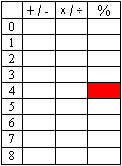Solve problems involving ratios.
Number Framework Stage 8
Unilink cubes
Using Materials
Tell the students to make up three stacks of 10 cubes made up as follows: 3 yellow with 7 blue, 5 yellow with 5 blue, and 4 yellow with 6 blue.
For each stack of cubes, ask the students to say what fraction and percentage of each stack is yellow or blue. Record their answers as:
.gif)
Problem: “If I combine stack A and stack B by putting them together in this container(or bag), what fraction and percentage of the total will each colour be?”
The students should observe that the combined number of yellows will be 3 + 5 = 8 and the combined total of blues will be 7 + 5 = 12. So the total fractions and percentages are 8/20 = 40% (yellow) and 12/20 = 60% (blue). Ask the students if they could have guessed the combined proportions from the fractions from each stack. Note that simply adding the fractions does not give the answer, that is, 3/10 + 5/10 = 8/10 for yellows, as the initial fractions and the answer fractions have different denominators, 10 and 20. Recording the initial stacks as ratios may help, 3:7 combined with 5:5 gives a combined ratio of 8:12.
The students will need to recognise the subtle connection between ratios and fractions, that is, 8:12 means 8/20 of the cubes are yellow, not 8/12.
Combine other collections of stacks and ask the students to work out the fractions and percentages for each collection; Stack A with Stack C (7 yellow:13 blue), Stack B with Stack C (9 yellow:11 blue), Stack A, Stack B, and Stack C together (12 yellow:18 blue). With each problem, expect the students to anticipate the combined proportions.
Introduce a new stack (D) made from 40 cubes, 23 yellow and 17 blue. Tell the students that you are going to combine the 40 cube stack with each of the 10 cube stacks in turn to see what the combined proportions will be. Ask the students what they expect. They should note that the 40 cube stack proportions will have four times the “weight” in determining the combined proportions.
Using Imaging
Pose similar problems but mask the materials. Get the students to anticipate the combined proportions and express them as fractions and percentages. Expect the students to record their thinking on paper as an aid to communication.
Problems might be:
2 yellow:8 blue with 8 yellow:2 blue (10:10 and 50%:50%),
7 yellow:3 blue with 5 yellow:15 blue (12:18 and 40%:60%)
15 yellow:5 blue with 3 yellow:37 blue (18:42 and 30%:70%)
Using Number Properties
Increase the difficulty of the problems by making the bases of the proportions nonmultiples of 10, using three colours (for example, white) and removing cubes rather than combining them. Record the problems in table form, for example:
Other problems might be:
8 yellow:5 blue:4 white with 11 yellow:11 blue:11 white (19:16:15 and 38%:32%:30%)
4 yellow:10 blue:5 white with 8 yellow:2 blue:11 white (12:12:16 and 30%:30%:40%)
Begin with 14 yellow:11 blue:5 white and remove 7 yellow:2 blue:1 white (7:9:4 and 35%:45%:20%).


